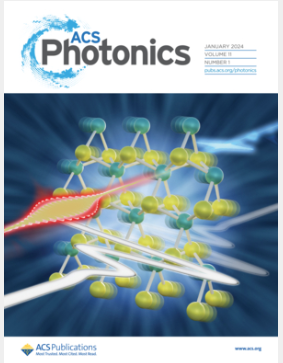基于DFB-SA自激活MAC函数的多模态识别光子神经网络
IF 6.7
1区 物理与天体物理
Q1 MATERIALS SCIENCE, MULTIDISCIPLINARY
引用次数: 0
摘要
受生物神经系统的启发,多模态深度学习集成了多模态信息来增强感知和决策,但其高计算需求在能效和速度上挑战了传统微电子处理器。光子神经形态计算提供了一个很有前途的解决方案,但实现线性加权和非线性激活通常需要不同的光子材料和器件,这使得大规模集成变得复杂。在这里,我们提出并展示了一种基于分布式反馈激光器和可饱和吸收器(DFB-SA)阵列的混合光电神经网络架构,旨在模拟生物视听融合,用于多模态识别任务。该架构利用了DFB-SA激光器的自激活多重累积(MAC)功能,将线性加权和非线性激活无缝集成到单个器件中,从而显著提高了集成效率。所提出的多模态神经网络在识别精度和鲁棒性方面优于单模态识别方法,在硬件推理中达到90%以上的准确率。每个计算核的速度为1.6 GOPS,能效为38.1 GOPS/W,单位面积速度为21.3 GOPS/mm2,整体性能随核数线性扩展。此外,我们利用DFB-SA激光神经元的自激活MAC功能开发了机器人避障系统。这项工作提出了一个用于多模态深度学习的高性能计算硬件平台,展示了其在模拟生物多感官识别和实现可扩展光子人工智能模型方面的潜力。本文章由计算机程序翻译,如有差异,请以英文原文为准。

Photonics Neural Networks for Multimodal Recognition Based on the Self-Activated MAC Function of DFB-SA
Inspired by biological nervous systems, multimodal deep learning integrates multimodal information to enhance perception and decision-making, yet its high computational demands challenge traditional microelectronic processors in energy efficiency and speed. Photonic neuromorphic computing offers a promising solution, but implementing linear weighting and nonlinear activation typically requires different photonic materials and devices, complicating large-scale integration. Here, we propose and demonstrate a hybrid optoelectronic neural network architecture based on a distributed feedback laser with a saturable absorber (DFB-SA) array, designed to mimic biological audiovisual fusion for multimodal recognition tasks. This architecture leverages the self-activated multiply accumulate (MAC) function of the DFB-SA laser, seamlessly integrating both linear weighting and nonlinear activation into a single device, thus significantly improving integration efficiency. The proposed multimodal neural network outperforms unimodal recognition methods in recognition accuracy and robustness under challenging conditions, achieving over 90% accuracy in hardware inference. Each computational core achieves a speed of 1.6 GOPS, an energy efficiency of 38.1 GOPS/W, and a unit area speed of 21.3 GOPS/mm2, with overall performance scaling linearly with the number of cores. Furthermore, we develop a robot obstacle avoidance system utilizing the self-activated MAC function of DFB-SA laser neurons. This work presents a high-performance computing hardware platform for multimodal deep learning, demonstrating its potential for simulating biological multisensory recognition and enabling scalable photonic AI models.
求助全文
通过发布文献求助,成功后即可免费获取论文全文。
去求助
来源期刊

ACS Photonics
NANOSCIENCE & NANOTECHNOLOGY-MATERIALS SCIENCE, MULTIDISCIPLINARY
CiteScore
11.90
自引率
5.70%
发文量
438
审稿时长
2.3 months
期刊介绍:
Published as soon as accepted and summarized in monthly issues, ACS Photonics will publish Research Articles, Letters, Perspectives, and Reviews, to encompass the full scope of published research in this field.
 求助内容:
求助内容: 应助结果提醒方式:
应助结果提醒方式:


